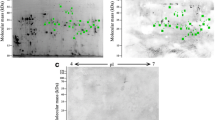Abstract
Trichinella spiralis and Trichinella nativa are both common wildlife parasites in Finland. However, they differ substantially in their resistance to below 0°C temperatures in their natural hosts. T. nativa can live in frozen fox meat for years, whereas T. spiralis dies when frozen. In mouse muscle, the difference is not as evident; even T. nativa cannot maintain infectivity when kept at −20°C for 1 week. Crude larval protein extracts of these two parasite species were analyzed by two-dimensional gel electrophoresis (2DE). The protein patterns showed clear differences, but matrix-assisted laser desorption/ionization-time of flight (MALDI-TOF) peptide mass fingerprint followed by database searches failed to identify these proteins, suggesting that they may still be uncharacterized. The patterns compared after freezing treatment at −20°C revealed changes in the intensity of some protein spots. The antigenic differences of the species were analyzed with two-dimensional Western blots, which showed T. spiralis-specific proteins.



Similar content being viewed by others
References
Al-Sherbiny MM, Farrag AA, Fayad MH, Makled MK, Tawfeek GM, Ali NM (2004) Application and assessment of a dipstick assay in the diagnosis of hydatidosis and trichinosis. Parasitol Res 93(2):87–95
Bruschi F, Murrell KD (2002) New aspects of human trichinellosis: the impact of new Trichinella species. Postgrad Med J 78:15–22
Dea-Ayuela MA, Ubeira FM, Pitarch A, Gil C, Martinez-Fernandez AR, Bolas F (2001) A comparison of antigenic peptides in muscle larvae of several Trichinella species by two-dimensional Western-blot analysis with monoclonal antibodies. Parasite 8:117–119
Escalante M, Romaris F, Rodriguez M, Rodriguez E, Leiro J, Garate MT, Ubeira FM (2004) Evaluation of Trichinella spiralis larva group 1 antigens for serodiagnosis of human trichinellosis. J Clin Microbiol 42:4060–4066
Gamble HR, Bessonov AS, Cuperlovic K, Gajadhar AA, van Knapen F, Noeckler K, Schenone H, Zhu X (2000) International Commission on Trichinellosis: recommendations on methods for the control of Trichinella in domestic and wild animals intended for human consumption. Vet Parasitol 93:393–408
Gamble HR, Pozio E, Bruschi F, Nockler K, Kapel CM, Gajadhar AA (2004) International Commission on Trichinellosis: recommendations on the use of serological tests for the detection of Trichinelia infection in animals and man. Parasite 11:3–13
Garate T, Rivas L (1987) Comparative study on polypeptide patterns of larvae of Trichinella isolates by two-dimensional electrophoresis. J Helminthol 61:225–228
Harrison HH, Miller KL, Dickinson C, Daufeldt JA (1992) Quality assurance and reproducibility of high-resolution two-dimensional electrophoresis and silver staining in polyacrylamide gels. Am J Clin Pathol 97:97–105
Homan WL, Derksen AC, van Knapen F (1992) Identification of diagnostic antigens from Trichinella spiralis. Parasitol Res 78:112–119
Jasmer DP (1990) Trichinella spiralis: altered expression of muscle proteins in trichinosis. Exp Parasitol 70:452–465
Kapel CM, Pozio E, Sacchi L, Prestrud P (1999) Freeze tolerance, morphology, and RAPD-PCR identification of Trichinella nativa in naturally infected arctic foxes. J Parasitol 85:144–147
Kapel CM, Oivanen L, La Rosa G, Mikkonen T, Pozio E (2001) Evaluation of two PCR-based techniques for molecular epidemiology in Finland, a high-endemic area with four sympatric Trichinella species. Parasite 8:39–43
Knowles MR, Cervino S, Skynner HA, Hunt SP, de Felipe C, Salim K, Meneses-Lorente G, McAllister G, Guest PC (2003) Multiplex proteomic analysis by two-dimensional differential in-gel electrophoresis. Proteomics 3:1162–1171
Nareaho A, Sankari S, Mikkonen T, Oivanen L, Sukura A (2000) Clinical features of experimental trichinellosis in the raccoon dog (Nyctereutes procyonoides). Vet Parasitol 91:79–91
Oivanen L, Kapel CM, Pozio E, La Rosa G, Mikkonen T, Sukura A (2002) Associations between Trichinella species and host species in Finland. J Parasitol 88:84–88
Pozio E, La Rosa G, Rossi P, Murrell KD (1992) Biological characterization of Trichinella isolates from various host species and geographical regions. J Parasitol 78:647–653
Pozio E, La Rosa G, Amati M (1993) Campbell WC, Pozio E, Bruschi F (eds) pp 173–178
Pozio E, Foggin CM, Marucci G, La Rosa G, Sacchi L, Corona S, Rossi P, Mukaratirwa S (2002) Trichinella zimbabwensis n.sp. (Nematoda), a new non-encapsulated species from crocodiles (Crocodylus niloticus) in Zimbabwe also infecting mammals. Int J Parasitol 32:1787–1799
Sukura A, Nareaho A, Mikkonen T, Niemi M, Oivanen L (2002) Trichinella nativa and T. spiralis induce distinguishable histopathologic and humoral responses in the raccoon dog (Nyctereutes procyonoides). Vet Pathol 39:257–265
Wang YY, Cheung PY, Wong MS, Lo SC (2003) “Two-in-one” gel for spot matching after two-dimensional electrophoresis. Proteomics 3:580–583
Wharton DA (2003) The environmental physiology of Antarctic terrestrial nematodes: a review. J Comp Physiol [B] 173:621–628
Wu Z, Nagano I, Takahashi Y (1999) A panel of antigens of muscle larvae of Trichinella spiralis and T. pseudospiralis as revealed by two-dimensional Western blot and immunoelectron microscopy. Parasitology 118(Pt 6):615–622
Yera H, Andiva S, Perret C, Limonne D, Boireau P, Dupouy-Camet J (2003) Development and evaluation of a Western blot kit for diagnosis of human trichinellosis. Clin Diagn Lab Immunol 10:793–796
Zarlenga DS, Chute MB, Martin A, Kapel CM (1999) A multiplex PCR for unequivocal differentiation of all encapsulated and non-encapsulated genotypes of Trichinella. Int J Parasitol 29:1859–1867
Acknowledgements
We thank Dr. Nisse Kalkkinen and Gunilla Rönnholm for the expertise concerning MALDI-TOF and Docent Pekka Varmanen for helping with PDQuest software. The study was supported by the Finnish Veterinary Foundation. The authors declare that the experiments comply with the current laws in Finland.
Author information
Authors and Affiliations
Corresponding author
Rights and permissions
About this article
Cite this article
Näreaho, A., Ravanko, K., Hölttä, E. et al. Comparative analysis of Trichinella spiralis and Trichinella nativa proteins by two-dimensional gel electrophoresis. Parasitol Res 98, 349–354 (2006). https://doi.org/10.1007/s00436-005-0086-7
Received:
Accepted:
Published:
Issue Date:
DOI: https://doi.org/10.1007/s00436-005-0086-7




